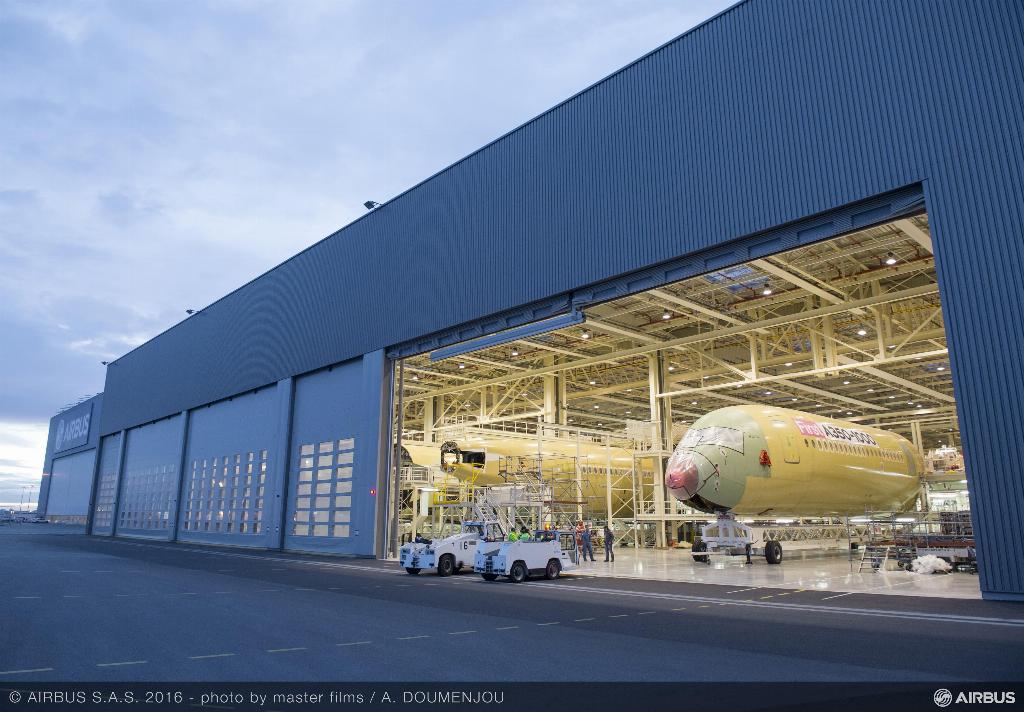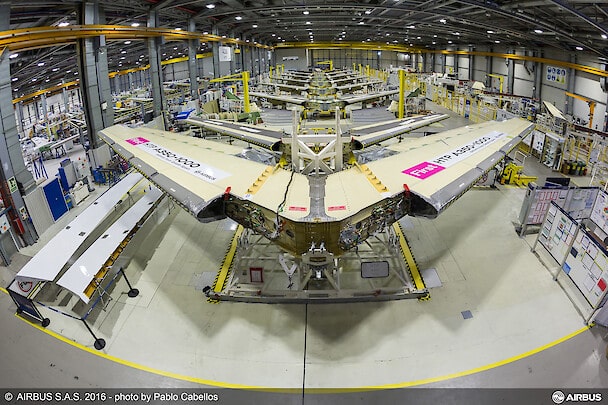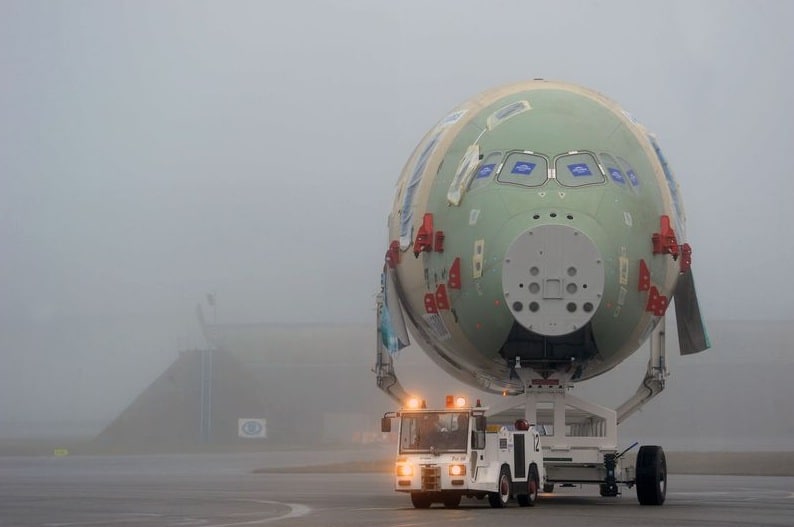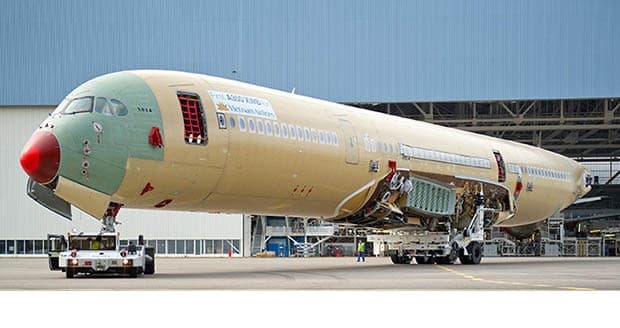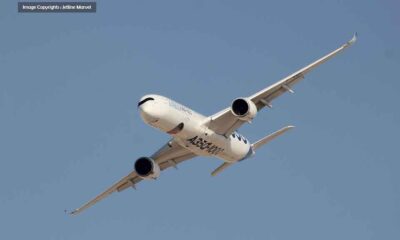Aerospace
How Airplanes are made ? Airbus A350 Aircraft Construction process.

The aeroplane is such a wonderful machine for getting us from one point to another. It also allows us to enjoy the view of the city from above the sky while saving us valuable time. You surely have wondered at some point how these aeroplanes are constructed and what the underlying science is, therefore we will cover that in the video. Let’s get start
How do the LCH and Dhruv Helicopter Surveillance Cameras function?(Opens in a new browser tab)
Making an aircraft requires a lot of science and engineering, thus it is not a simple task. For the first time, the Wright brothers took to the skies. It made its maiden flight over Kitty Hawk, North Carolina, on December 17, 1903, with Orville in charge of the controls. Later, aviation technology advanced more and more. There are several companies that manufacture aircraft today, and they differ based on the needs of the clients.
One of the most cutting-edge aeroplanes currently in production, the Airbus A350, will be covered in this article. This wide-body aircraft can be used for longer journeys and has a carrying capacity of more than 350 passengers. This plane has a 19-hour flight range.
What is special about the Airbus A350?
A lot of engineering is needed to produce such aeroplanes, and Airbus conducts all of the work in various parts of Europe. In the initial stage company analyses market demands to develop the aircraft, A team of engineers will construct the aircraft and subject it to rigorous testing. Three aeroplanes will be produced initially, and they will be put through rigorous testing.
Where do Airbus get their parts from? (Logistics)
Beluga, is an unusual cargo plane designed by Airbus that resembles a fish and transports all the necessary components to the assembly site a few parts, such as engines and other heavy objects, have also been found in water and on roads. Manufacturing relies heavily on logistics to keep production moving along and complete tasks on schedule.
What is the A350 fuselage made of? (Fuselage Assembly)
It is one of the primary sections of the aeroplane and houses all of its parts, including the area where passengers are transported. Final Assembly Lines (FALs) for Airbus is located in Toulouse, France. where everything comes together and combines at this point. Airlines can operate more efficiently and with fewer carbon emissions thanks to the A350’s 53% composite material content. The A350 XWB is the first airbus to haveits wing structures and fuselage made of carbon-fibre reinforced plastic. The fuselage is often divided into three main segments: the front, the rear, and the middle, where it is connected together with the aid of the rivets, which firmly hold this component. As you can see in this video, the fuselage of the aircraft comes together and becomes its shape.
Does the A350 have composite wings? (Wing assembly)
Even if the engine fails, the wings are still the second-most crucial component of the aeroplane since they aid in gliding and landing. This is a very important component, and Airbus tests many levels of wing construction before selecting the best and strongest one to use in the aeroplane. Wings support the left and right engines, as well as the gasoline inside. With the aid of flaps, they also assist in lifting the aircraft off the ground.
The lightweight carbon composites make up the majority of the A350 XWB’s wing, including its upper and lower covers. These are some of the largest carbon fibre single aviation parts ever manufactured, measuring 32 metres long by six metres wide.
Empennage or tail assembly.
The vertical tail of the aircraft aids in keeping it going forward in a single direction, and it also aids in turning the aircraft in any direction. The most important part of this aircraft is its wings and tail, without which it cannot be controlled. This section is operated by a fly-by-wire system that responds to commands from the captain.
Engine
The engine, which generates the amorphous thrust that propels the aeroplane forward, is the main component that really generates the forward motion. Typically, the aircraft manufacturer will select the engine based on the size and capacity requirements. Before deciding whether an engine is safe for operation, it will undergo a variety of tests, including running in various weather conditions for a number of hours. Airbus constantly ensures that aeroplanes are kept safe and swift because engine parts endurance is one of the toughest problems. The Rolls-Royce Trent XWB engine, installed by airbus in the A350, generates 431.5-kilo newton of thrust.
A350 Avionics
The nervous system of an aircraft is made up of avionics and instruments, which give the cockpit constant updates on the status of the aircraft and its systems. Further cockpit developments are crucial because the cockpit serves as the primary control centre for an aircraft. The majority of Airbus aeroplanes have a fly-by-wire technology, which uses electric actuators to control hydraulic controls to further reduce weight due to the aircraft’s small size. The cockpit instruments receive data from all the instruments that collect information from various sensors and ground communication devices. Pilot makes the necessary decisions for flying after considering all the information.
Indigo to add Boeing 777 wide body aircraft in its fleet.(Opens in a new browser tab)
Painting Section.
The airlines chose the painting in accordance with their brand identity, theme colours, and logo choice. however, the majority of aircraft are often painted white. The entire painting process takes place in a closed room with high ceilings. In order to protect the aircraft body from heat, two layers will be painted on it: a base layer and a primary layer. Additionally, a designer will create the airline’s logo and name, which will be carefully painted on the aircraft.
Interior of cabins
The primary airline signature style is found in the cabin interior. Long-haul flights typically use the A350, and in order to maximise passenger comfort, airlines luxuriously furnish the cabin and offer the nicest seats available. After the customer’s choice is made, some vendors who work in tandem with the Airbus firm construct demo examples for the client. Interiors of the cabins’ seats will be created. Airlines often have two primary sections: a business class and a premium or economics class.
Test phase
After completing all necessary steps, the aircraft will be checked for taxing and many other functions before being handed over to the owner.
Tell us in the comments what component of the aircraft you find most interesting. Isn’t it remarkable how an aircraft is built? Thank you for watching; if you like it, please let others know.

Aerospace
India is currently in the process of developing its own 72-seater aircraft.
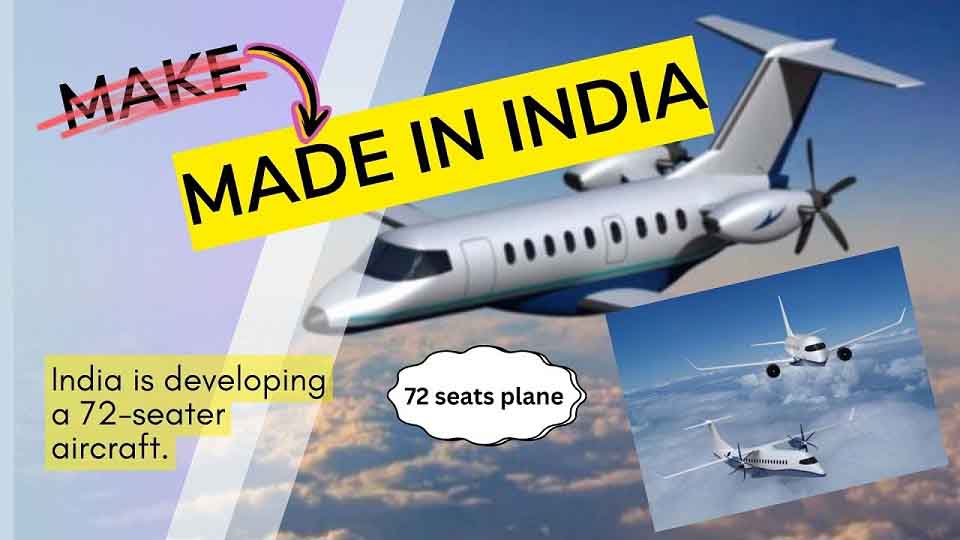
India stands on the cusp of pioneering its aircraft development, a potential reality in the near future. With the Indian aviation market poised to become one of the world’s top five largest markets, there’s a burgeoning demand for carriers like Indigo, Air India, and Akasa. Together, they’ve placed orders for over 1400 aircraft from Boeing and Airbus, marking one of the highest orders in the aviation industry.
‘Made in India’ passenger aircraft.
To transform the dream of a ‘Made in India’ passenger aircraft into reality and propel the local aerospace ecosystem, India requires a comprehensive National Aerospace Policy. Notably, Airbus and Boeing have yet to establish final aircraft assembly lines (FALs) within India, spurred by the significant orders received.
India has exerted considerable pressure to establish assembly lines domestically, mirroring the success of similar initiatives abroad. With its aviation market growing at an unprecedented rate, India boasts the largest order book for new aircraft, estimated at a staggering $70 billion over the next decade. Existing airports bustle with travelers while new ones are either under construction or in the planning phase.
The timeline for India to realize the Prime Minister’s vision of a Made in India commercial aircraft hinges on various factors. Leveraging its prowess in exporting IT services and aerospace technologies, India is poised for the next stage of development.
The success rate of China’s C919 and ARJ21.
In the realm of commercial aerospace manufacturing, Europe and the US have long held the reins, but China has emerged as a formidable contender in recent years. China’s journey began in 2002 with the ARJ21, a regional jet, and later the C919, a larger narrow-body aircraft. While the ARJ21 encountered delays and is seen as a modest achievement, the C919 boasts over one thousand orders, marking a significant success.
Both programs heavily rely on foreign technologies sourced from global original equipment manufacturers (OEMs), underscoring the importance of collaborations and creating an appealing environment for foreign companies to operate within China.
Indian HAL has 80 years of history.
India, too, boasts a rapidly growing aerospace sector that traces its roots back to pre-independence times, predating China’s endeavors by over 60 years. Hindustan Aeronautics Ltd (HAL), initially established as Hindustan Aircraft Ltd in 1940, spearheaded this journey. Given its early establishment, India was poised to become a major player in aerospace manufacturing.
HAL shoulders much of the responsibility for developing aircraft for defense purposes, including the TEJAS, attack and multirole helicopters, trainer aircraft, and notably, the Dornier D228, a passenger version aircraft representing a significant breakthrough for the Indian Aerospace Industry. Demand for helicopters is also on the rise, further showcasing India’s potential in the aerospace domain.
India’s aviation market Demand.
One drawback in the defense sector is the inherent uncertainty surrounding government budgets and delays in allocating funds for helicopter purchases. On the civilian front, aircraft demand remains consistently high, especially when they meet passenger needs and receive regular approvals from authorities.
India’s aviation market is distinct, calling for unique aircraft programs. With a high density of flyers, there’s a prevalent preference for short-haul flights from rural areas to major cities. As the air travel network expands to Tier-2 and Tier-3 cities, the number of operational airports is expected to surge from the current 140 to 230-240.
The demand for smaller aircraft, particularly for serving Tier 1-3 cities, is paramount for airlines. While the Dornier aircraft has been utilized for some routes, its availability limitations and noise levels have raised concerns. Jet planes emerge as preferable options for Indian travelers due to their efficiency and comfort, aligning better with the needs of airlines.
Establishing a sustainable aircraft program requires long-term commitment and substantial risk capital, often necessitating government support akin to what’s observed in developed markets. For instance, COMAC, over its lifetime, received significant state-related support ranging from $49-72 billion, while Airbus, over the years, obtained $22 billion from the EU.
Encouraging private investment is crucial for fostering growth in the aerospace sector and nurturing indigenous aircraft development in India. Such initiatives could significantly bolster the country’s aviation industry and enhance its self-reliance in this critical domain.
Indian Regional Jet (IRJ).
Introducing the Indian Regional Jet (IRJ), a cutting-edge project led by India’s National Aerospace Laboratories (NAL) and set to be manufactured by Hindustan Aeronautics Limited (HAL). This regional airliner aims to redefine air travel with its design, offering a capacity of 80–100 passengers. The base model, known as the RTA-70, will boast 80–90 seats while distinguishing itself with a cost that’s 20 percent lower than its global counterparts.
Development is well underway, with plans for a 90-seater variant expected to take flight by 2026. This next-generation aircraft promises impressive specs, including a range of 1,350 nm (2,500 km), and requiring a take-off and landing field length of 900m (2,950 ft). With dimensions of 28.6m in length and a wingspan of 29.4m, it reaches a service ceiling of 30,000 ft and cruises at 300kt, all while meeting Stage 4 noise criteria.
Saras Aircraft.
Meanwhile, NAL’s innovative spirit extends to the NAL Saras, another project in the works. Already, prototypes like the Mark1 and its successor, the second version dubbed ‘Mark 2,’ are pushing boundaries. The Saras Mark 2 showcases versatility, offering ranges of 600 km with 19 passengers, 1,200 km with 14 passengers, and an impressive 2,000 km with eight passengers. With a top cruise speed exceeding 600 km/h and an endurance of six hours, it’s a game-changer.
Weights
Max. take-off : 7600 kg (16755 lb)
Operating empty wt. : 5100 kg (11244 lb)
Max. fuel weight : 1832 kg (4039 lb)
Max. pay load : 1710 kg (3770 lb)
Power plant
SARAS is powered by two Pratt and Whitney Canada.
PT6A-67A turbo-prop engines (flat rated to 1200 shp)
driving 2.6 m diameter 5 bladed constant speed propellers
at 1700 rpm in a Tractor configuration.
Main dimensions
Span : 18 m (59.05 ft)
Length : 17.3 m (56.8 ft)
Height : 5.5 m (18 ft)
Performance (ISA)
Take-off distance : 820 m (2690 ft)
Landing distance : 665 m (2182 ft)
Max. rate of climb : 10 m/s (1980 ft/min)
Max. range* (19 pax) : 750 km (405 nm)
Max. range* (10 pax) : 2350 km (1270 nm)
Ferry range* : 2400 km (1295 nm)
Max. cruise speed : 485 km/hr (260 Kts)
Endurance : 6 hours . With 45 min reserve
Equipped with propeller engines initially, the Saras is poised for future upgrades to jet engines if project requirements align. NAL’s ambition shines through in its cost-effective approach, targeting ₹50 crore per unit for the Saras Mk2, undercutting the ₹55 crore Dornier 228 with its unpressurized cabin and altitude restrictions. Anticipating government support, NAL aims to secure orders for 50-60 units to ensure manufacturing viability, with an initial order of 15 aircraft from the Indian Air Force potentially expanding to 120–140 units in the coming years.
Aerospace
Top 10 world’s best military drones in 2024
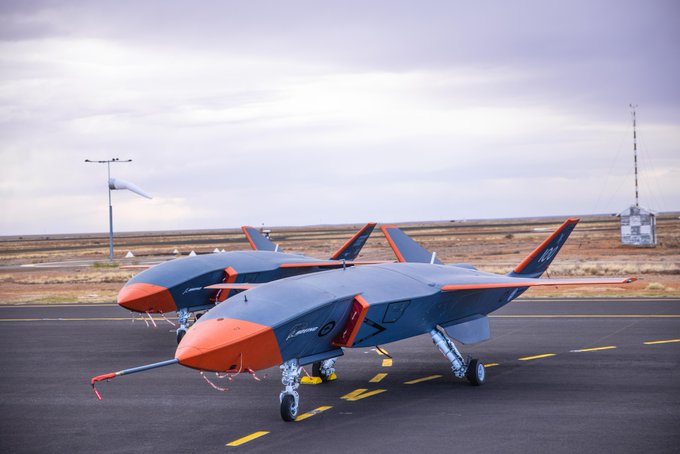
In an age defined by rapid technological advancement and strategic military innovation, the role of unmanned aerial vehicles, commonly known as drones, has become increasingly pivotal on the modern battlefield.
As we step into 2024, the global landscape of military drones continues to evolve, with nations investing heavily in cutting-edge technologies to maintain superiority in reconnaissance, surveillance, and combat operations.
Join us as we delve into the top 10 military drones that are shaping the future of warfare, showcasing their capabilities and impact on the ever-changing theater of conflict.
1. Boeing MQ-28 Ghost Bat :This aircraft represents a cutting-edge advancement in unmanned combat aerial vehicles, currently under development by Boeing Australia. As a Loyal Wingman class aircraft, it is engineered to seamlessly integrate with existing military aircraft, enhancing and extending airborne missions through its stealth capabilities and multirole functionality. With an impressive range surpassing 2,000 nautical miles and a combat radius of 900 miles, it promises to revolutionize aerial operations. Anticipated to join the ranks of the RAAF in 2024-25, these unmanned platforms herald a new era in military aviation.
2.The Bayraktar TB2: stands as a formidable medium-altitude long-endurance (MALE) unmanned combat aerial vehicle, crafted by the Turkish company Baykar. Renowned for its prowess, Bayraktar drones have found their way into the arsenals of numerous nations worldwide, seeing action in various conflicts including the Russian invasion of Ukraine and the Tigray War. Featuring a sleek blended wing body design complemented by an inverted V-tail structure, the TB2 platform exemplifies innovation in aerial technology. With an approximate price tag of 5 million US dollars per unit, it represents a significant investment in defense capabilities.
3. Bayraktar Kızılelma: A cutting-edge project by Turkish defense company Baykar, introduces a single-engine, low-observable, carrier-capable, jet-powered unmanned combat aerial vehicle. It boasts a sleek, supersonic airframe designed for reduced radar cross-section (RCS) and is outfitted with an advanced AESA radar system. Its operational combat radius spans 500 nautical miles. Weighing in at a maximum takeoff weight (MTOW) of 6,000 kilograms (13,200 lb), it reserves 1,500 kg for payload capacity. Already, two prototypes have been manufactured, with plans for operational deployment expected by 2025.
4. XQ-58 Valkyrie: is a cutting-edge unmanned flying machine (drone) built for the U.S. Air Force. Designed by Kratos Defense, this high-tech aircraft is like a silent wingman, following a manned fighter jet and carrying out various missions. These missions could include scouting ahead for dangers, providing extra firepower, or even acting as a decoy to protect the manned aircraft. It boasts a maximum range extending approximately 3,000 miles, with a hefty maximum launch weight capped at 6,500 pounds. This figure includes the capacity to accommodate up to 600 pounds within its internal payload bay and an additional 600 pounds beneath its wings.
5.TAI Aksungur: is a heavyweight drone built for the Turkish Armed Forces. Designed by Turkish Aerospace Industries, it boasts an impressive wingspan of 12 meters (39 feet) and can carry a significantly larger payload than its predecessor. The Aksungur’s central fuselage, housed beneath the wings, is the brain of the operation. The range of this drone extends to 6,500 kilometers and payload capacity is 750 kg. It carries all the avionics, camera systems, and sensors the drone needs to function. An additional camera mounted on the chin provides a clear view directly below the aircraft.
6.Hongdu GJ-11: It is Sharp Sword is a marvel of Chinese aviation technology. This unmanned aerial vehicle (UAV), also known as a drone, is designed for stealth and long-range combat missions. The Sharp Sword’s tailless flying wing design makes it difficult to detect on radar. Internally, it houses two weapon bays, allowing it to carry a variety of armaments for air-to-surface strikes.
While the exact engine remains unknown, reported specifications boast an impressive range of 2,485 miles (4,000 kilometers) and accommodates internal weapons bays capable of carrying payloads of up to 2,000 kilograms (4,400 lbs). This combination of stealth, firepower, and range makes the GJ-11 a significant player in modern aerial warfare.
7.Dassault Neuron: is a pioneering unmanned combat aerial vehicle (UCAV) built through a collaborative effort by European nations. This high-tech drone serves as a technological demonstrator, paving the way for future autonomous combat aircraft.
Designed for stealth and independent operation, the nEUROn is built to handle the toughest combat environments. With a sleek design measuring 10 meters long and 12 meters wide, it has an estimated unit cost of €25 million if a production version were built. The nEUROn’s demonstrator model weighs approximately 5 tons and showcases the potential for future European-built combat drones. It has capability to transport two laser-guided 250 kg bombs, each housed in its own weapon bay.
8.The Sukhoi S-70 Okhotnik-B: also known as Hunter-B, is a formidable unmanned combat aerial vehicle (UCAV) under development by Russia’s Sukhoi company. Designed to strike fear into the hearts of enemies, this high-tech drone is built for stealthy operation.
The Okhotnik-B boasts a flying-wing design, a favorite technique for minimizing radar detection. Its construction incorporates composite materials and special stealth coatings to further reduce its radar signature.Powering this aerial predator is an AL-31 turbojet engine, allowing it to reach estimated speeds of 1,000 kilometers per hour with a range of 6,000 kilometers.
9.The Northrop Grumman X-47B: is a groundbreaking unmanned combat aerial vehicle (UCAV) designed for launching and landing on aircraft carriers. This American marvel, developed by Northrop Grumman, is a tailless jet with a unique blended-wing-body design. This design helps it cut through the air efficiently. It can operate semi-autonomously, meaning it can fly pre-programmed missions with some human oversight.The X-47B can refuel in the air, extending its range for even longer missions at sea. The X-47B drone boasts an approximate range of 2,100 nautical miles.
10.CAIG Wing Loong II:
The Chengdu GJ-2, also known as the Wing Loong II, is a powerful unmanned aerial vehicle (UAV) built for long-range strikes. Developed by the Chengdu Aircraft Industry Group, this drone can be controlled remotely or fly autonomously using pre-programmed missions.
An upgrade from its predecessor, the Wing Loong I, II boasts a larger body and wider wingspan, allowing it to carry an impressive payload. This drone can pack a punch with up to 480 kilograms of laser-guided bombs and missiles. The manufacturer even claims it has the potential to carry air-to-air weaponry, making it a versatile threat in the skies.It can carry a maximum payload of 400 kilograms.
Aerospace
India is set to build a central command for the Air Traffic Control system, called ISHAN

India’s air traffic growth has led to increased responsibilities for air traffic control. The Airports Authority of India (AAI) is considering centralizing air traffic control for aircraft, dividing the country into four regions. The goal is to consolidate India’s segmented airspace into a single entity to improve air traffic management (ATM) efficiency, safety, and smoothness.
Recently, the AAI invited expressions of interest to develop a detailed project report for the Indian Single Sky Harmonized Air Traffic Management (ISHAN) initiative in Nagpur. Under this plan, air traffic controllers in Nagpur would handle domestic flights flying above 25,000 feet, eliminating the need for coordination among controllers in different regions.
For domestic regional flights operating above 25,000 feet, control would shift to the central command in Nagpur. This consolidation aims to enhance airline operations, increase flight handling capacity, and reduce congestion and flight times for passengers.
Currently, the AAI provides ATM services over Indian airspace and adjoining oceanic areas, covering over 2.8 million square nautical miles. This airspace is divided into four flight information regions (FIRs) in Delhi, Mumbai, Kolkata, and Chennai, along with a sub-FIR in Guwahati.
FIRs are responsible for providing air traffic services, including weather information, visibility, and search and rescue assistance. The proposed unification under the ISHAN initiative aligns with the projected growth of the aviation industry, which anticipates a doubling of domestic passenger traffic by 2030.

